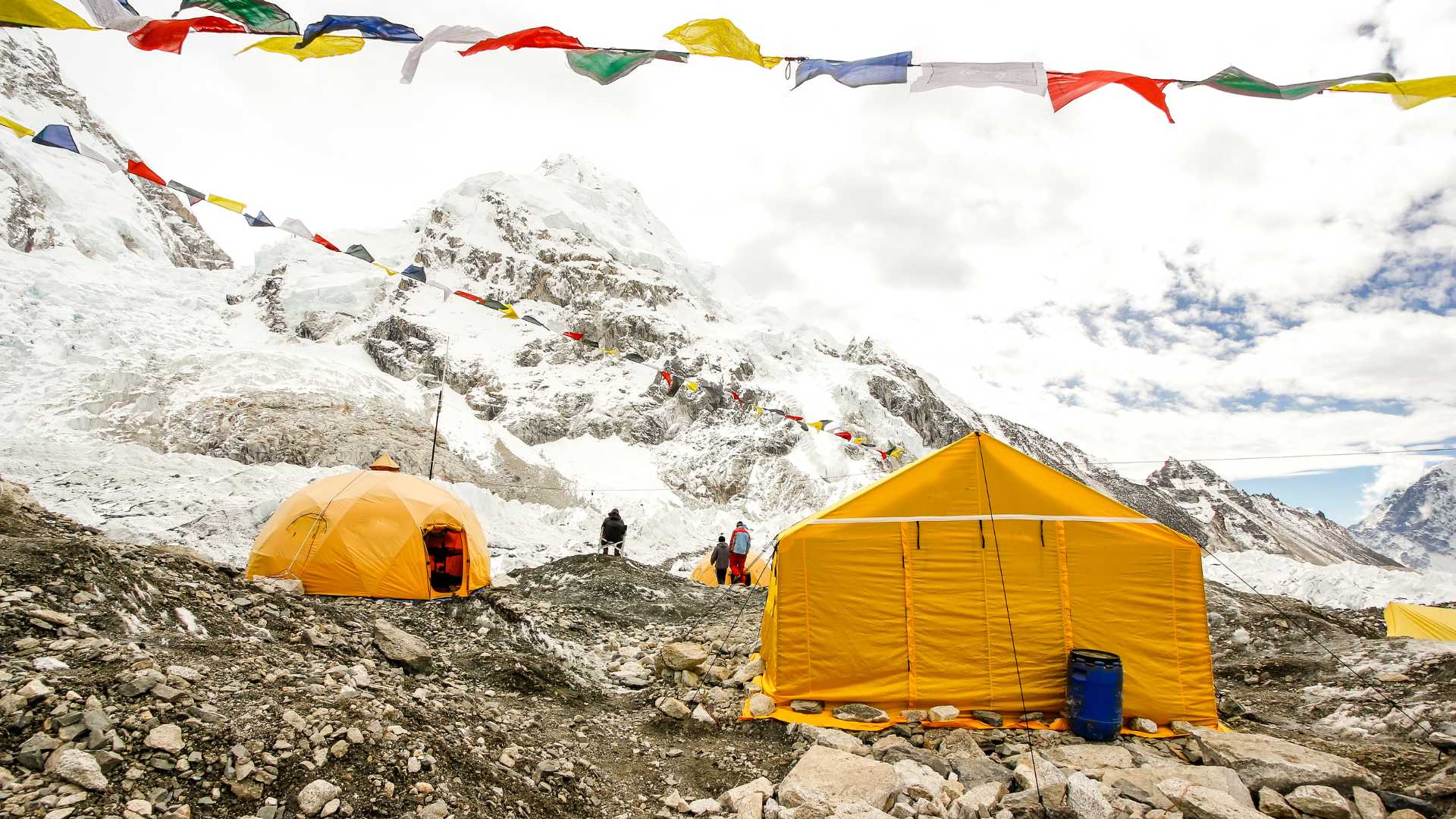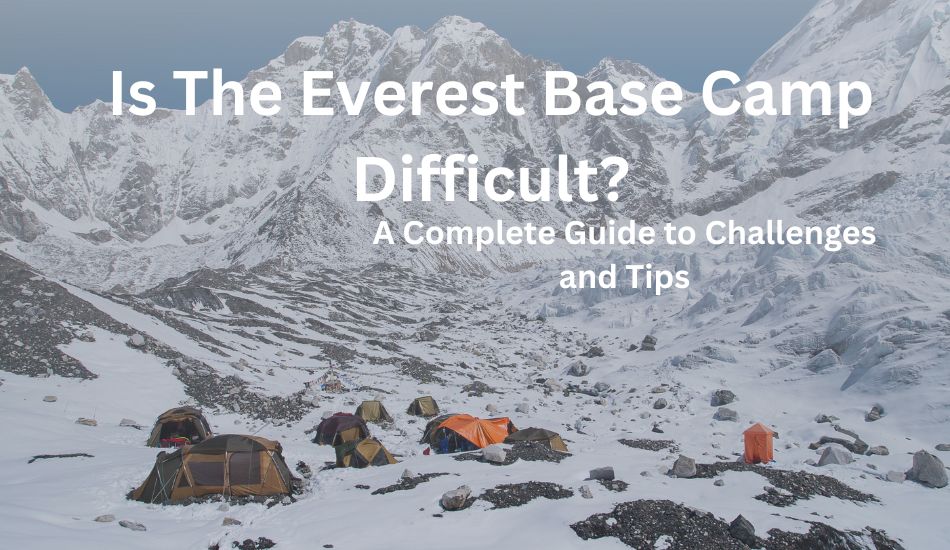Everest Base Camp Difficult: A Complete Guide to Challenges and Tips
Is The Everest Base Camp Difficult?
The Everest Base Camp difficulties are one important component of this once-in-a-lifetime journey into the Himalayas, where every step taken by an adventurer has its share of problems. The journey is meant to be rich in panoramas, cultural peculiarities, and mountain scenery; thus, great effort should be balanced with great reward. Every day brings its mix of excitement, natural beauty, and physical effort from the busy streets of Kathmandu to the lively Sherpa villages and on to EBC.

Why is it essential to understand the challenges?
1. Preparation Minimizes Risk
Altitude sickness and the sudden change in weather contribute to understanding how a trekker should better prepare and reduce health risks while making the trip as safe as possible.
2. Physical and Mental Readiness
Knowing the physical demands and mental strength required will enable trekkers to prepare in advance, making the journey more enjoyable with less fatigue.
3. Financial Planning
Understanding the Everest base camp trek cost, including the budget for gear, permits, and guides, allows one to budget effectively for the trip and avoid any surprises that would add to the stress.
Everest Base Camp Trekking Routes
4. Better Experience
It would also be more comfortable for the trekkers, considering there are really difficult parts of experiencing multiple types of terrain and cold nights. They can shift all their attention towards the beauty and cultural richness during this process rather than getting preoccupied with the demands of the trek. For better experience you can learn about the seasons for the best time to visit Everest Base Camp Trek.
5. Building Realistic Expectations
Understanding what's to come provides realistic expectations, which help keep spirits up and prevent disappointment when the trek might be a bit more difficult than expected.
Must Read: How To Trek To Everest Base Camp
Who this trek is best suited for?
While the trek is quite doable for most people, is Everest Base Camp dangerous? It certainly can be if one needs to prepare both physically and mentally. The trek is best suited for trekkers with average physical fitness, mental stamina, and a mountain fascination. The Everest base camp height reaches 5,364 meters, so it's paramount for trekkers to be prepared for high altitude.
This trek tempts experienced trekkers and people with a deep enthusiasm for the mountains. However, even beginners can emerge successfully with good guidance, physical training, and an open mindset toward facing challenges.
What Makes the EBC Trek Challenging?
Altitude and Its Effects on Your Body
The altitude of Everest Base Camp is 5,364 meters (17,598 feet) above sea level, propelling trekkers into high-altitude conditions that could have extremely recognizable effects on the body.
a. Understanding Altitude Sickness and Acclimatization
Altitude sickness is one of the most common problems at EBC. The lower level of oxygen at high altitudes may stress the body. Proper acclimatization helps the body get used to thin air gradually; thus, you stand a better chance of not developing serious altitude-related problems.
b. Symptoms to Watch Out For
Headaches
Nausea and loss of appetite
Fatigue and weakness
Shortness of breath
Dizziness and lightheadedness
Sleep disturbances
Confusion and loss of coordination (severe symptom)
c. Tips to Handle Them
Stay hydrated
Pace yourself
Avoid alcohol and caffeine
Eat light, frequent meals
Practice deep breathing
Take rest days
Keep warm
Use medication if needed
Descend if severe symptoms occur
Length and Duration of the Trek
a. Overview of Trekking Days and Daily Hours on the Trail
The EBC trek generally lasts 12 to 14 days, depending on the selected itinerary and additional acclimatization days. Trekkers normally walk for about 4 to 8 hours daily; it covers difficult tracks and rocky terrain, occasionally steep up-and-downs, testing endurance and stamina.
Featured Trip: 17-Days Everest Base Camp Trek
b. Why the Duration Can Be Physically and Mentally Demanding
Extended trekking days
High-altitude fatigue
Limited rest days
Challenging terrain
Monotony of routine
Isolation and limited comforts
Weather changes
Sleep disruptions
Terrain and Weather Conditions
Types of Terrain You’ll Encounter
Rocky paths
Steep inclines
Narrow mountain passes
Forest trails
River crossings
Uneven, loose ground
Snow and ice patches (depending on the season)
Weather Variability and How It Impacts the Trek
The weather in the Himalayas is always fully unpredictable. While the temperatures can change between warm afternoons and freezing nights, a snowstorm or rain suddenly develops an added layer of difficulty. These weather changes make route finding difficult and further impact comfort and safety on the trail. Preparation with correct attire, waterproof equipment, and solid footwear is essential to dealing well with this trek feature.
Recommednation Read: Learn About How Difficult Is Upper Dolpo Caravan
Physical Fitness and Preparation
Recommended Fitness Level for the Trek
Ideal Fitness Level
A moderate fitness level is required, as the trek involves long days of walking at high altitudes. It’s ideal for individuals who can comfortably walk 5–10 kilometers on uneven terrain without fatigue.
Exercises and Training Tips to Prepare
Cardio: running, hiking, cycling to improve cardiovascular endurance
Strength Training: squats, lunges, planks to strengthen legs, core, and upper body
Hiking Practice: hike uphill with a pack to simulate on-trail conditions
Endurance Workouts: extended, consecutive walking/hiking sessions to build stamina
Stair Climbing: stairs or stair machines to build leg strength for steep climbs
Yoga or Stretching: flexibility and balance to handle rough terrain
Core Workouts: Emphasize planks and leg raises to stabilize during hikes
Weight Training: Incorporate light weights to build muscle endurance and carry a pack.
Learn more on our blog, Essential Trekking Preperations For Nepal.
Packing the Right Gear and Essentials
Essential Trekking Gear for Comfort and Safety:

Backpack
Sleeping bag
Trekking poles
Headlamp/flashlight
Water purification system
First aid kit
Portable charger/power bank
Multi-tool or knife
Camera/phone for photos
Insect repellent
Clothing and Equipment for Extreme Weather:
Layered clothing (thermal base layers, fleece jackets, waterproof outer layers)
Warm gloves and hat
Sturdy, waterproof hiking boots
Sunscreen and sunglasses
Gaiters
Insulated jacket
Waterproof pants
Buff or neck gaiter
Warm socks (preferably wool)
Windproof jacket
What To Pack For Everest Base Camp Trek?
Tips for a Successful Trek
Plan a great deal by researching the trek, forecasted weather conditions, and the route conditions on the trail. Ensure equipment is prepared and packed in advance.
Hydrate well, nourish yourself with plenty of water, and eat nutritious meals for energy.
Take your time. There is a rhythm to keeping the body current so it has plenty of time to acclimate to the altitude.
Take more frequent breaks to preserve energy and freshen up, leading to increased stamina.
Be more aware of body changes that may show discomfort or altitude sickness, and take your rest or go down when necessary.
Dress appropriately, using multiple layers of clothes to change with the weather, mainly at high altitudes.
Wear proper shoes, including waterproof fitted boots that are comfortable and protect you from blister formation.
Enjoy yourself and be positive; trekking to base camp may also be psychologically demanding.
Bring extra clothes for cold or rainy weather, and check the weather forecast daily. Consider hiring a guide or porter, as it will give you valuable local insight support and take some load off by carrying your gear.
Featured Trip: 27-Days Mugu Dolpo Trek Via GHT
Final Thoughts
The EBC trek is a challenging yet satisfying journey in itself. It hardly gets bigger in terms of timber views and cultural experiences. Though the trek is tiring, the return to Base Camp makes it all worthwhile. From finding your right footstep to guiding your life, Dolpo Caravan Treks stands ready for your assistance throughout the incredible adventure. Let us make your dream trek come true.
FAQs
Is the Everest Base Camp difficult?
Yes, it can be challenging, as the Everest Base Camp trek involves high altitude, lengthy days of trekking, and rugged terrain. However, most trekkers find it very manageable, provided they are prepared with appropriate measures and good fitness. Acclimatization and pacing hold the key to a successful completion.
Is Everest Base Camp dangerous?
The trek is not technical and dangerous, but the altitude may allow for serious risks, such as altitude sickness. Without proper acclimatization, a trekker may have symptoms of dizziness or nausea. It is important to go by gradual ascend and recognize symptoms early.
How long does it take to reach EBC?
Normally, the EBC trek takes about 12 to 14 days. These days include trekking and rest days, which are important for proper acclimatization to avoid altitude sickness. This keeps the adventure well-paced to ensure safety and enjoyment.
What is the best time to trek to Everest Base Camp?
The best times for the EBC trek are during the pre-monsoon and post-monsoon seasons, respectively. These months offer stable weather, clear skies, and pleasant trekking conditions, making it easier to enjoy the views.
Do I need an EBC trek guide?
While independent trekking is possible, hiring guides is extremely recommended. This creates a much safer experience that is greatly enriching in many ways. Guides will help you navigate the trails, assist with acclimatization, and provide valuable cultural insights to enhance your adventure.



Leave Your Comment